Advertisements
Advertisements
प्रश्न
In figure, two positive charges q2 and q3 fixed along the y axis, exert a net electric force in the + x direction on a charge q1 fixed along the x-axis. If a positive charge Q is added at (x, 0), the force on q1
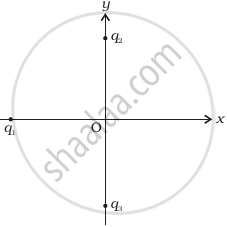 (a) |
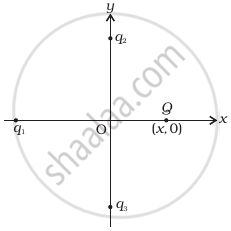 (b) |
विकल्प
shall increase along the positive x-axis.
shall decrease along the positive x-axis.
shall point along the negative x-axis.
shall increase but the direction changes because of the intersection of Q with q2 and q3.
उत्तर
shall increase along the positive x-axis.
Explanation:
Total force acting on a given charge due to the number of charges is the vector sum of the individual forces acting on that charge due to all the charges.
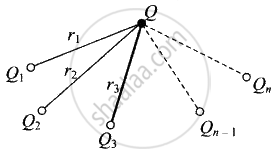
Consider the number of charges Q1, Q2, Q3, ... are applying force on a charge Q.
Net force in Q will be `vecF_("net") = vecF_1 + vecF_2 + ... vecF_(n - 1) + vecF_n`
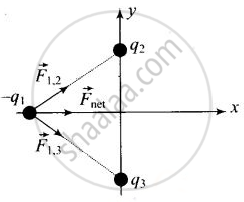
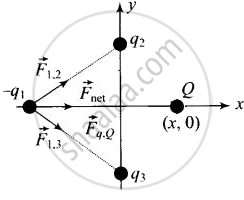
We know that like charges repel and unlike charges attract. The net electrostatic force on the charge qx by the charges q2 and q3 is along the positive x-direction. Hence the nature of force between q1, q2 and q1, q3 should be attractive. It means qx should be negative. This can be represented by the figure given alongside:
Now a positive charge Q is placed at (x, 0), hence the nature of force between q1 and Q (positive) will be attractive and the force on q1 by the charge Q should be along the positive x-axis direction. Now we can say that the net force on the charge qx due to charges q2, q3 and Q should be along the same direction as given in the diagram alongside:
Now it is clear from the figure given above that the force on qx shall increase along the positive x-axis due to the presence of positive charge Q placed at (x, 0).
APPEARS IN
संबंधित प्रश्न
Why do the electrostatic field lines not form closed loops?
A point charge (+Q) is kept in the vicinity of an uncharged conducting plate. Sketch the electric field lines between the charge and the plate?
The figure shows the field lines on a positive charge. Is the work done by the field in moving a small positive charge from Q to P positive or negative? Give reason.
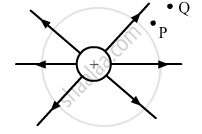
Two bar magnets are quickly moved towards a metallic loop connected across a capacitor ‘C’ as shown in the figure. Predict the polarity of the capacitor.

The intensity of the electric field at a perpendicular distance of 0·5 m from an infinitely long line charge having linear charge density (λ) is 3-6 × 103 Vm-1. Find the value of λ.
Draw the pattern of electric field lines, when a point charge –Q is kept near an uncharged conducting plate.
Answer the following question.
Derive an expression for the electric field due to a dipole of dipole moment `vec"p"` at a point on its perpendicular bisector.
Explain why two field lines never cross each other at any point?
The magnitude of the electric field due to a point charge object at a distance of 4.0 m is 9 N/C. From the same charged object the electric field of magnitude, 16 N/C will be at a distance of ______.
